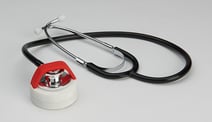Buckle In, It’s Time to Geek Out!
We set out to answer two questions. ‘Why are simulator sounds so crappy?’ and ‘How could we make the implementing of quality vital sounds more affordable?’
After doing a fair amount of research regarding the vital sounds of all patient simulators on the market, we discovered the following:
The sound is unrealistic because: The speakers are placed inside the manikin and become muffled by the plastics placed on top of them. This results in a sound nothing like professionals expect. And understandably so – although a true sound is recorded, it’s played through a buried speaker!
It’s expensive for manufacturers because: For every sound location, you must have a tiny speaker. And at every sound location you must continuously play audio, which means complicated electronics and multi-channel audio.
We can do better. We have used two new technologies that, together, make realistic sounds possible:
Using wireless Bluetooth technology, we can put the speaker right next to the diaphragm of a stethoscope. So, instead of the sound coming from the manikin, it’s playing clearly from the stethoscope itself. And to think, just a decade ago, this wasn’t possible – small powered wireless speakers were cumbersome and Bluetooth was expensive.
Harnessing proximity sensors: a small piece of specially manufactured, durable film. The film is not fragile, it’s wireless, it doesn’t require a battery or power at all – it’s completely passive. These location tags or location ID stickers are placed under the skin of the simulator in customized locations. The proximity sensors transition from passive to active when the diaphragm of the stethoscope, which has an active sensor inside, is near the film. Sounds are set and controlled by ALEX – set and change as needed by the simulator.
Introducing The SmartScope™ (Patent Pending)
 Grab the SmartScope™, put it on – you won’t hear anything. Put the stethoscope diaphragm near the heart, and heart sounds begin to play with amazing purity. And here’s the kicker: Using these sensors, ALEX can log when and where the stethoscope has been placed. We believe this will provide a better user ‘sound’ experience, add insight to debriefings, reduce ‘things that break’ in a manikin, and add a new layer of affordability to your simulator.
Grab the SmartScope™, put it on – you won’t hear anything. Put the stethoscope diaphragm near the heart, and heart sounds begin to play with amazing purity. And here’s the kicker: Using these sensors, ALEX can log when and where the stethoscope has been placed. We believe this will provide a better user ‘sound’ experience, add insight to debriefings, reduce ‘things that break’ in a manikin, and add a new layer of affordability to your simulator.
Introducing The SmartCuff™ (Patent Pending)
With the blood pressure cuff, we set out to do one thing: simplify. A blood pressure cuff requires a T-shaped intersection in the tubing to allow pumped air to flow simultaneously into the cuff and into the manometer. Current simulators are built with blood pressure sensors within the torso connected by tubing coming out of the sides of the manikin.
We can do better. We can employ the SmartScope™ to work in sync with short and small pieces of electronics we’ve built into the cuff. These short, small pieces of electronics are Bluetooth Low Energy enabled air pressure sensors, and do not interfere with the inflation of the cuff. Oh, AND, the lifespan of the SmartCuff™ battery is several years
